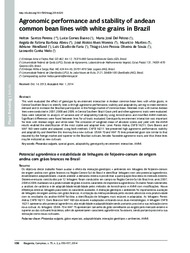Agronomic performance and stability of andean common bean lines with white grains in Brazil.
Agronomic performance and stability of andean common bean lines with white grains in Brazil.
Autoria: PEREIRA, H. S.; BUENO, L. G.; DEL PELOSO, M. J.; ABREU, A. de F. B.; MOREIRA, J. A. A.; MARTINS, M.; WENDLAND, A.; FARIA, L. C. de; SOUZA, T. L. P. O. de; MELO, L. C.
Resumo: This work evaluated the effect of genotype by environment interaction in Andean common bean lines with white grains, in Central Southern Brazil, to identify lines with high agronomic performance, stability and adaptability, aiming to meet domestic demand and to increase the Brazilian participation in the foreign market of common bean. Nineteen trials with twelve Andean lines were conducted in 2007, 2008 and 2009, in Central Southern Brazil. Grain yield and other agronomic traits were evaluated. Data were subjected to analysis of variance and of adaptability/stability using Annicchiarico and modified AMMI methods. Significant differences were found between lines for all traits evaluated. Genotype by environment interaction was important for lines with Andean origin and white seed. The utilization of weighted mean of absolute scores and yield with the AMMI results enabled the identification of the most stable and adapted lines. Lines Poroto Alubia, CNFB 16211, Ouro Branco and WAF 160 were stable and adapted, using both methods. CNFB 16211 line presented high agronomic performance, stability and adaptability and therefore this line may be a new cultivar. USWA 70 and WAF 75 lines presented grain size similar to that required by the foreign market and superior to the Brazilian cultivars, besides favorable agronomic traits, and thus these lines may be indicated as new cultivars.
Ano de publicação: 2014
Tipo de publicação: Artigo de periódico
Unidade: Embrapa Arroz e Feijão
Palavras-chave: Ammi, Feijão, Grão branco, Grão especial, Interação genética, Melhoramento genético vegetal, Phaseolus vulgaris
Observações
1 - Por padrão são exibidas publicações dos últimos 20 anos. Para encontrar publicações mais antigas, configure o filtro ano de publicação, colocando o ano a partir do qual você deseja encontrar publicações. O filtro está na coluna da esquerda na busca acima.
2 - Para ler algumas publicações da Embrapa (apenas as que estão em formato ePub), é necessário ter, no celular ou computador, um desses softwares gratuitos. Sistemas Android: Google Play Livros; IOS: iBooks; Windows e Linux: software Calibre.
Acesse outras publicações
Acesse a Base de Dados da Pesquisa Agropecuária (BDPA) para consultar o acervo completo das bibliotecas da Embrapa.

